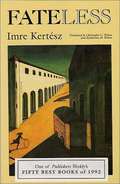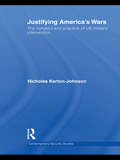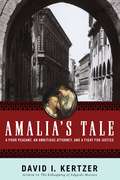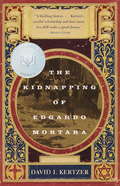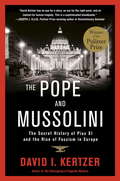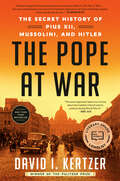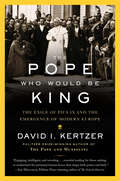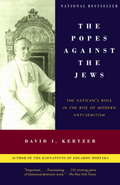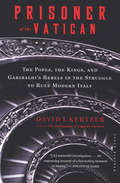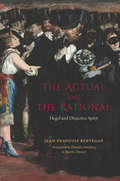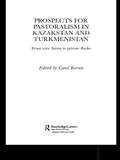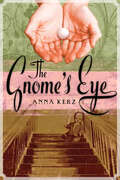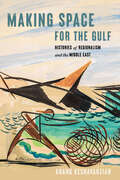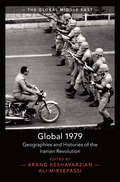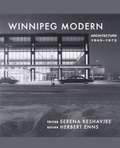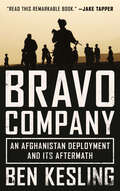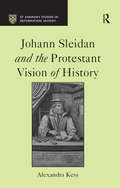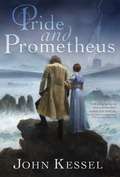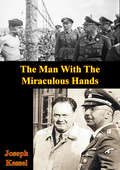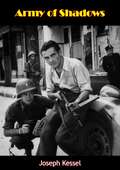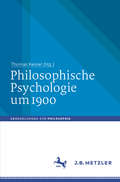- Table View
- List View
Fateless
by Imre Kertész Christopher C. Wilson Kathryn M. WilsonEnglish translation of a moving and disturbing novel about a Hungarian Jewish boy's experiences in German concentration camps and his attempts to reconcile himself to those experiences after the war. Returning to his native Budapest, still clad in prison clothes, George experiences a variety of emotions, ultimately coming to the conclusion that neither his Jewishness nor his Hungarianness will solve his fate.
Justifying America's Wars: The Conduct and Practice of US Military Intervention (Contemporary Security Studies)
by Nicholas Kerton-JohnsonThis book examines the justifications for, and practice of, war by the US since 1990, and examines four case studies: the Gulf War, Kosovo, Afghanistan and Iraq. The author undertakes an examination of presidential speeches and public documents from this period to determine the focal points on which the respective presidents based their rhetoric for war. The work then examines the practice of war in the light of these justifications to determine whether changes in justifications correlate with changes in practice. In particular, the justificatory discourse finds four key themes that emerge in the presidential discourses, which are tracked across the case studies and point to the fundamental driving force in US motivations for going to war. The four key themes which emerge from the data are: international law or norms; human rights; national interest; and egoist morality (similar too, but wider than, 'exceptionalism'). This analysis shows that 9/11 resulted in a radical shift away from an international law and human rights-focused justificatory discourse, to one which was overwhelmingly dominated by egoist-morality justifications and national interest. This book will be of much interest to students of US foreign policy, humanitarian intervention, Security Studies, and IR theory.
Loving Isaac and A Groom for Greta
by Rebecca Kertz Anna SchmidtExperience love and healing in these Amish tales Loving Isaac by Rebecca Kertz Back in his Amish community, Isaac Lapp works to rebuild his tattered reputation. His one saving grace is childhood pal Ellen Mast. But even though Ellen's kindness and beauty are helping him become more confident each day, the lure of the non-Amish world beckons. Isaac must make a choice: a life beyond Happiness, Pennsylvania...or the woman who might just become his forever home. A Groom for Greta by Anna Schmidt When Greta Goodloe's longtime sweetheart ends their engagement, she decides to take comfort in matchmaking her quiet schoolmarm sister with handsome newcomer Luke Starns. Yet the more she tries to throw them together, the more Luke fascinates her. And Luke can't help but be charmed by Greta's warm smile. Does he dare to stray from the sensible choice and take a chance on happiness?
Amalias Tale
by David I. KertzerThis quintessential David-and-Goliath saga tells the story of a wholly unexpected triumph of the poor against the rich and of a crusading city attorney who fought on behalf of an impoverished peasant. Amalia Bagnacavalli, an illiterate young peasant from the mountains near Bologna, is forced by poverty to take in a child from the city’s foundling home to wet-nurse. When Amalia contracts syphilis from the sickly and malformed baby given to her, the city fathers callously dismiss her pleas for treatment and restitution. Bewildered and frightened, she seeks out Augusto Barbieri, an ambitious attorney looking to make a name for himself. He takes up Amalia’s cause, fighting the case for years through the Italian courts before winning an unprecedented and stunning victory for his by now broken client. The unforgettable story of a landmark struggle for basic human rights, Amalia’s Tale is the moving drama of a rural woman whose life was ruined and the man from the city who would not stop -- or so it seemed -- until he had seen justice done.
The Kidnapping of Edgardo Mortara
by David I. KertzerNational Book Award Finalist Bologna: nightfall, June 1858. A knock sounds at the door of the Jewish merchant Momolo Mortara. Two officers of the Inquisition bust inside and seize Mortara's six-year-old son, Edgardo. As the boy is wrenched from his father's arms, his mother collapses. The reason for his abduction: the boy had been secretly "baptized" by a family servant. According to papal law, the child is therefore a Catholic who can be taken from his family and delivered to a special monastery where his conversion will be completed. With this terrifying scene, prize-winning historian David I. Kertzer begins the true story of how one boy's kidnapping became a pivotal event in the collapse of the Vatican as a secular power. The book evokes the anguish of a modest merchant's family, the rhythms of daily life in a Jewish ghetto, and also explores, through the revolutionary campaigns of Mazzini and Garibaldi and such personages as Napoleon III, the emergence of Italy as a modern national state. Moving and informative, the Kidnapping of Edgardo Mortara reads as both a historical thriller and an authoritative analysis of how a single human tragedy changed the course of history.(From the Trade Paperback edition.)
The Pope and Mussolini: The Secret History of Pius XI and the Rise of Fascism in Europe
by David I. KertzerFrom National Book Award finalist David I. Kertzer comes the gripping story of Pope Pius XI's secret relations with Italian dictator Benito Mussolini. This groundbreaking work, based on seven years of research in the Vatican and Fascist archives, including reports from Mussolini's spies inside the highest levels of the Church, will forever change our understanding of the Vatican's role in the rise of Fascism in Europe. The Pope and Mussolini tells the story of two men who came to power in 1922, and together changed the course of twentieth-century history. In most respects, they could not have been more different. One was scholarly and devout, the other thuggish and profane. Yet Pius XI and "Il Duce" had many things in common. They shared a distrust of democracy and a visceral hatred of Communism. Both were prone to sudden fits of temper and were fiercely protective of the prerogatives of their office. ("We have many interests to protect," the Pope declared, soon after Mussolini seized control of the government in 1922.) Each relied on the other to consolidate his power and achieve his political goals. In a challenge to the conventional history of this period, in which a heroic Church does battle with the Fascist regime, Kertzer shows how Pius XI played a crucial role in making Mussolini's dictatorship possible and keeping him in power. In exchange for Vatican support, Mussolini restored many of the privileges the Church had lost and gave in to the pope's demands that the police enforce Catholic morality. Yet in the last years of his life--as the Italian dictator grew ever closer to Hitler--the pontiff's faith in this treacherous bargain started to waver. With his health failing, he began to lash out at the Duce and threatened to denounce Mussolini's anti-Semitic racial laws before it was too late. Horrified by the threat to the Church-Fascist alliance, the Vatican's inner circle, including the future Pope Pius XII, struggled to restrain the headstrong pope from destroying a partnership that had served both the Church and the dictator for many years. The Pope and Mussolini brims with memorable portraits of the men who helped enable the reign of Fascism in Italy: Father Pietro Tacchi Venturi, Pius's personal emissary to the dictator, a wily anti-Semite known as Mussolini's Rasputin; Victor Emmanuel III, the king of Italy, an object of widespread derision who lacked the stature--literally and figuratively--to stand up to the domineering Duce; and Cardinal Secretary of State Eugenio Pacelli, whose political skills and ambition made him Mussolini's most powerful ally inside the Vatican, and positioned him to succeed the pontiff as the controversial Pius XII, whose actions during World War II would be subject for debate for decades to come. With the recent opening of the Vatican archives covering Pius XI's papacy, the full story of the Pope's complex relationship with his Fascist partner can finally be told. Vivid, dramatic, with surprises at every turn, The Pope and Mussolini is history writ large and with the lightning hand of truth. Advance praise for The Pope and Mussolini "David Kertzer has an eye for a story, an ear for the right word, and an instinct for human tragedy. They all come together in The Pope and Mussolini to document, with meticulous scholarship and novelistic flair, the complicity between Pius XI and the Fascist leader in creating an unholy alliance between the Vatican and a totalitarian government rooted in corruption and brutality. This is a sophisticated blockbuster."--Joseph J. Ellis, Pulitzer Prize-winning author of Revolutionary Summer
The Pope at War: The Secret History of Pius XII, Mussolini, and Hitler
by David I. KertzerNEW YORK TIMES BESTSELLER • &“The most important book ever written about the Catholic Church and its conduct during World War II.&”—Daniel Silva&“Kertzer brings all of his usual detective and narrative skills to [The Pope at War] . . . the most comprehensive account of the Vatican&’s relations to the Nazi and fascist regimes before and during the war.&”—The Washington Post Based on newly opened Vatican archives, a groundbreaking, explosive, and riveting book about Pope Pius XII and his actions during World War II, including how he responded to the Holocaust, by the Pulitzer Prize–winning author of The Pope and MussoliniWINNER OF THE JULIA WARD HOWE AWARD • LONGLISTED FOR THE PEN/JACQUELINE BOGRAD WELD AWARD • ONE OF THE BEST BOOKS OF THE YEAR: The New YorkerWhen Pope Pius XII died in 1958, his papers were sealed in the Vatican Secret Archives, leaving unanswered questions about what he knew and did during World War II. Those questions have only grown and festered, making Pius XII one of the most controversial popes in Church history, especially now as the Vatican prepares to canonize him.In 2020, Pius XII&’s archives were finally opened, and David I. Kertzer—widely recognized as one of the world&’s leading Vatican scholars—has been mining this new material ever since, revealing how the pope came to set aside moral leadership in order to preserve his church&’s power.Based on thousands of never-before-seen documents not only from the Vatican, but from archives in Italy, Germany, France, Britain, and the United States, The Pope at War paints a new, dramatic portrait of what the pope did and did not do as war enveloped the continent and as the Nazis began their systematic mass murder of Europe&’s Jews. The book clears away the myths and sheer falsehoods surrounding the pope&’s actions from 1939 to 1945, showing why the pope repeatedly bent to the wills of Hitler and Mussolini.Just as Kertzer&’s Pulitzer Prize–winning The Pope and Mussolini became the definitive book on Pope Pius XI and the Fascist regime, The Pope at War is destined to become the most influential account of his successor, Pius XII, and his relations with Mussolini and Hitler. Kertzer shows why no full understanding of the course of World War II is complete without knowledge of the dramatic, behind-the-scenes role played by the pope. &“This remarkably researched book is replete with revelations that deserve the adjective &‘explosive,&’&” says Kevin Madigan, Winn Professor of Ecclesiastical History at Harvard University. &“The Pope at War is a masterpiece.&”
The Pope Who Would Be King: The Exile of Pius IX and the Emergence of Modern Europe
by David I. KertzerThe Pulitzer Prize–winning author of The Pope and Mussolini takes on a pivotal, untold story: the bloody revolution that stripped the pope of political power and signaled the birth of modern Europe. Days after his prime minister was assassinated in the middle of Rome in November 1848, Pope Pius IX found himself a virtual prisoner in his own palace. The wave of revolution that had swept through Europe now seemed poised to end the popes’ thousand-year reign over the Papal States, if not to the papacy itself. Disguising himself as a simple parish priest, Pius escaped through a back door. Climbing inside the Bavarian ambassador’s carriage, he embarked on a journey into a fateful exile. Only two years earlier Pius’s election had triggered a wave of optimism across Italy. After the repressive reign of the dour Pope Gregory XVI, Italians saw the youthful, benevolent new pope as the man who would at last bring the Papal States into modern times and help create a new, unified Italian nation. But Pius was caught between a desire to please his subjects and a fear—stoked by the conservative cardinals—that heeding the people’s pleas would destroy the church. The resulting drama—with a colorful cast of characters, from Louis Napoleon and his rabble-rousing cousin Charles Bonaparte to Garibaldi, Tocqueville, and Metternich—was rife with treachery, tragedy, and international power politics. David Kertzer is one of the world’s foremost experts on the history of Italy and the Vatican and has a rare ability to bring that history vividly to life. With a combination of gripping, cinematic storytelling and keen historical analysis, rooted in an unprecedented richness of archival sources, The Pope Who Would Be King sheds fascinating new light on the end of rule by divine right in the West and the emergence of modern Europe. Advance praise for The Pope Who Would Be King“In this original—and even thrilling—book, David Kertzer gives us a brilliant and surprising portrait of the role of Pius IX in the making of a new democratic reality in the West. Engaging, intelligent, and revealing, The Pope Who Would Be King is essential reading for those seeking to understand the perennial human forces that shape both power and faith.”—Jon Meacham, author of Thomas Jefferson: The Art of Power“In this riveting tour de force, Kertzer shows how and why Pope Pius IX turned Roman Catholicism into the nemesis of modernity, with drastic consequences not only for the church but for the West.”—James Carroll, author of The Cloister
The Popes Against the Jews: The Vatican's Role in the Rise of Modern Anti-Semitism
by David I. KertzerA groundbreaking historical study based on documents previously locked in the Vatican's secret archives: The Popes Against the Jews graphically shows how the Catholic Church helped make the Holocaust possible. Pope John Paul II, as part of his effort to improve Catholic-Jewish relations, has himself called for a clear-eyed historical investigation into any possible link be-tween the Church and the Holocaust. An important sign of his commitment was the recent decision to allow the distinguished historian David I. Kertzer, a specialist in Italian history, to be one of the first scholars given access to long-sealed Vatican archives. The result is a book filled with shocking revelations. It traces the Vatican's role in the development of modern anti-Semitism from the nineteenth century up to the outbreak of the Second World War. Kertzer shows why all the recent attention given to Pope Pius XII's failure to publicly protest the slaughter of Europe's Jews in the war misses a far more important point. What made the Holocaust possible was groundwork laid over a period of decades. In this campaign of demonization of the Jews--identifying them as traitors to their countries, enemies of all that was good, relentlessly pursuing world domination--the Vatican itself played a key role, as is shown here for the first time. Despite its focus, this is not an anti-Catholic book. It seeks a balanced judgment and an understanding of the historical forces that led the Church along the path it took. Inevitably controversial, written with devastating clarity and dispassionate authority,The Popes Against the Jewsis a book of the greatest importance.
Prisoner of the Vatican: The Popes, the Kings, and Garibaldi's Rebels in the Struggle to Rule Modern Italy
by David I. KertzerA Pulitzer Prize winner&’s &“fascinating&” account of the political battles that led to the end of the Papal States (Entertainment Weekly). From a National Book Award–nominated author, this absorbing history chronicles the birth of modern Italy and the clandestine politics behind the Vatican&’s last stand in the battle between the church and the newly created Italian state. When Italy&’s armies seized the Holy City and claimed it for the Italian capital, Pope Pius IX, outraged, retreated to the Vatican and declared himself a prisoner, calling on foreign powers to force the Italians out of Rome. The action set in motion decades of political intrigue that hinged on such fascinating characters as Garibaldi, King Viktor Emmanuel, Napoleon III, and Chancellor Bismarck. Drawing on a wealth of secret documents long buried in the Vatican archives, David I. Kertzer reveals a fascinating story of outrageous accusations, mutual denunciations, and secret dealings that will leave readers hard-pressed to ever think of Italy, or the Vatican, in the same way again. &“A rousing tale of clerical skullduggery and topsy-turvy politics, laced with plenty of cross-border intrigue.&” —Kirkus Reviews, starred review
The Actual and the Rational: Hegel and Objective Spirit
by Jean-Francois Kervegan Daniela Ginsburg Martin ShusterOne of Hegel’s most controversial and confounding claims is that “the real is rational and the rational is real.” In this book, one of the world’s leading scholars of Hegel, Jean-François Kervégan, offers a thorough analysis and explanation of that claim, along the way delivering a compelling account of modern social, political, and ethical life. Kervégan begins with Hegel’s term “objective spirit,” the public manifestation of our deepest commitments, the binding norms that shape our existence as subjects and agents. He examines objective spirit in three realms: the notion of right, the theory of society, and the state. In conversation with Tocqueville and other theorists of democracy, whether in the Anglophone world or in Europe, Kervégan shows how Hegel—often associated with grand metaphysical ideas—actually had a specific conception of civil society and the state. In Hegel’s view, public institutions represent the fulfillment of deep subjective needs—and in that sense, demonstrate that the real is the rational, because what surrounds us is the product of our collective mindedness. This groundbreaking analysis will guide the study of Hegel and nineteenth-century political thought for years to come.
Prospects for Pastoralism in Kazakstan and Turkmenistan: From State Farms to Private Flocks (Central Asia Research Forum)
by Carol KervenThis collection traces how pastoralists have coped with the challenges of change in a part of the world with a long-tradition of livestock keeping. Their precarious position - balanced between a market system where only the fittest may survive, and their attempt to remain a human resource for the future development of the natural pastures and livestock industry - is carefully and critically examined by the contributors. The pastoralists' unique skills at managing livestock in a variable and challenging environment, and their ability to supply commodities much in demand mean that an understanding of their societal position is essential for anyone interested in transition in the former Soviet Union.
Tales from the New Jersey Devils Locker Room: A Collection of the Greatest Devils Stories Ever Told (Tales from the Team)
by Mike Kerwick Glenn Chico ReschIn Tales from the New Jersey Devils Locker Room, former New Jersey goalie Chico Resch and coauthor Mike Kerwick bring readers along for a wild ride from the lean early seasons to the three Stanley Cup championships of this beloved team.
The Gnome's Eye
by Anna KerzIn the spring of 1954, when her father announces that the family has a chance to immigrate to Canada, Theresa's life changes forever. She and her family are wartime refugees from Yugoslavia, so it shouldn't be hard to leave Austria. But the weathered barracks of Lager Lichtenstein are the only home she knows, and they are filled with family and friends she doesn't want to leave behind. As she says her good-byes, Theresa's friend Martin gives her two gifts: a package of postcards and a stone he calls the Gnome's Eye, which he says will "protect her from all things evil, living or dead." Theresa is convinced the stone has no power, but she still keeps it close as they travel on the crowded immigrant ship and when they settle into a rooming house on Kensington Avenue in Toronto. At first Theresa is afraid of everything: the other tenants in the rooming house, the rat that lives in the kitchen, learning a new language. But as time goes by, Theresa's need for the Gnome's Eye fades, until she is finally able to give it to someone who needs it more than she does.
Making Space for the Gulf: Histories of Regionalism and the Middle East (Worlding the Middle East)
by Arang KeshavarzianThe Persian Gulf has long been a contested space—an object of imperial ambitions, national antagonisms, and migratory dreams. The roots of these contestations lie in the different ways the Gulf has been defined as a region, both by those who live there and those beyond its shore. Making Space for the Gulf reveals how capitalism, empire-building, geopolitics, and urbanism have each shaped understandings of the region over the last two centuries. Here, the Gulf comes into view as a created space, encompassing dynamic social relations and competing interests. Arang Keshavarzian writes a new history of the region that places Iran, Iraq, and the Arabian Peninsula together within global processes. He connects moments more often treated as ruptures—the discovery of oil, the Iranian Revolution, the rise and decline of British empire, the emergence of American power—and crafts a narrative populated by a diverse range of people—migrants and ruling families, pearl-divers and star architects, striking taxi drivers and dethroned rulers, protectors of British India and stewards of globalized American universities. Tacking across geographic scales, Keshavarzian reveals how the Gulf has been globalized through transnational relations, regionalized as a geopolitical category, and cleaved along national divisions and social inequalities. When understood as a process, not an object, the Persian Gulf reveals much about how regions and the world have been made in modern times. Making Space for the Gulf offers a fresh understanding of this globally consequential place.
Global 1979: Geographies and Histories of the Iranian Revolution (The Global Middle East #18)
by Arang Keshavarzian Ali MirsepassiThe Iranian revolution of 1979 not only had an impact on regional and international affairs, but was made possible by the world and time in which it unfolded. This multi-disciplinary volume presents this revolution within its transnational and global contexts. Moving deftly from the personal to the global and from the provincial to the national, it draws attention to the multiplicity of spaces of the revolution such as streets, schools, prisons, personal lives, and histories such as the Cold War and Global 1960s and 70s. With a broad range of approaches, Global 1979 conceives of the Iranian Revolution not as exceptional or anachronistic, but as an uprising constituted by multiple, interwoven geographies and histories, which disrupt static and bounded notions of the local, national, regional, and global.
Winnipeg Modern: Architecture, 1945 to 1975
by Serena KeshavjeeA vivid, stylish, and fascinating look at internationally acclaimed architects and their work.Beginning in the 1940s, John A. Russell, dean of the School of Architecture at the University of Manitoba, nurtured a strong tradition of Modernist design with close connections to architectural giants such as Mies van der Rohe and Walter Gropius. Under Russell’s guidance, a generation of young architects, such as James Donahue and David Thordarson, adapted the principles of European Modernism to the prairie geography. Other nationally renowned architects, such as Étienne Gaboury and Gustavo da Roza, also left a lasting Modernist mark on Winnipeg’s skyline and private residences.Edited by Serena Keshavjee and designed by architect Herbert Enns, Winnipeg Modern captures the grace and beauty of the Modernist period and includes critical and historical essays on the aesthetic and social project of Modernist architecture in Winnipeg. Lavishly illustrated with 300 photographs from provincial archives, the private archives of architect Henry Kalen, and contemporary photographer Martin Tessler, this book is a testament to the Modernist principles of structural expression and purity of form.
Dreams and visions in the early middle ages: the reception and use of patristic ideas, 400-900
by Jesse KeskiahoDreams and visions played important roles in the Christian cultures of the early middle ages. But not only did tradition and authoritative texts teach that some dreams were divine: some also pointed out that this was not always the case. Exploring a broad range of narrative sources and manuscripts, Jesse Keskiaho investigates how the teachings of Augustine of Hippo and Pope Gregory the Great on dreams and visions were read and used in different contexts. Keskiaho argues that the early medieval processes of reception in a sense created patristic opinion about dreams and visions, resulting in a set of authoritative ideas that could be used both to defend and to question reports of individual visionary experiences. This book is a major contribution to discussions about the intellectual place of dreams and visions in the early middle ages, and underlines the creative nature of early medieval engagement with authoritative texts.
Bravo Company: An Afghanistan Deployment and Its Aftermath
by Ben KeslingA timely, powerful, and sweeping portrait of a company of men who went to war in Afghanistan, their troubled deployment, and their lives since returning home “An honest account of bravery, sacrifice, and what it means to seek redemption. As a veteran of combat himself, Ben Kesling is able to intimately and honestly document war and its aftermath in ways others haven’t.” —Jake Tapper, CNN anchor In Bravo Company, journalist and veteran Ben Kesling tells the story of the war in Afghanistan through the eyes of the men of one unit, part of a combat-hardened parachute infantry regiment in the 82nd Airborne Division. A decade ago, the soldiers of Bravo Company deployed to Afghanistan for a tour in Kandahar’s notorious Arghandab Valley. By the time they made it home, three soldiers had been killed in action, a dozen more had lost limbs, and nearly half of the company had Purple Hearts. In the decade since, two of the soldiers have died by suicide, more than a dozen have tried, and others admit they’ve considered it. Declared an “extraordinary risk” by the Department of Veterans Affairs, the members of Bravo Company were chosen as test subjects for a new approach to the veteran crisis, focusing less on individuals and more on the group. Bravo Company has an insider’s eye and ear, and draws on extensive interviews and original reporting. It follows the men from their initial enlistment and training, through their deployment and a major shift in their mission, and then on to what has happened in the decade since as they returned to combat in other units or moved on with their lives as civilians, or struggled to do so. This is a powerful, insightful, and memorable account of a war that didn’t end for these soldiers just because they came home.
Johann Sleidan and the Protestant Vision of History (St Andrews Studies in Reformation History)
by Alexandra KessOne of the major challenges faced by the emergent Protestant faith was how to establish itself in a hitherto Catholic world. A key way it found to achieve this was to create a common identity through the fashioning of history, emphasising Protestantism's legitimacy and authority. In this study, the life and works of one of the earliest and most influential Protestant historians, Johann Sleidan (1506-1556) are explored to reveal how history could be used to consolidate the new confession and the states which adopted it. Sleidan was commissioned by leading intellectuals from the Schmalkadic League to write the official history of the German Protestant movement, resulting in the publication in 1555 of De statu religionis et reipublicae, Carolo Quinto, Caesare, Commentarii. Overnight his work became the standard account of the early Reformation, referenced by Catholics and Protestants alike in subsequent histories and polemical debates for the next three centuries. Providing the first comprehensive account of Sleidan's life, based almost entirely on primary sources, this book offers a convincing background and context for his writings. It also shows how Sleidan's political role as a diplomat impacted on his work as a historian, and how in turn his monumental work influenced political debate in France and Germany. As a moderate who sought to promote accommodation between the rival confessions, Sleidan provides a fascinating subject of study for modern historians seeking to better understand the complex and multi-faceted nature of the early Reformation.
Fifty Years of Women in Mathematics: Reminiscences, History, and Visions for the Future of AWM (Association for Women in Mathematics Series #28)
by Cathy Kessel Janet L. Beery Sarah J. GreenwaldThe Assocation for Women in Mathematics (AWM), the oldest organization in the world for women in mathematics, had its fiftieth anniversary in 2021. This collection of refereed articles, illustrated by color photographs, reflects on women in mathematics and the organization as a whole. Some articles focus on the situation for women in mathematics at various times and places, including other countries. Others describe how individuals have shaped AWM, and, in turn, how the organization has impacted individuals as well as the broader mathematical community. Some are personal stories about careers in mathematics. Fifty Years of Women in Mathematics: Reminiscences, History, and Visions for the Future of AWM covers a span from AWM’s beginnings through the following fifty years. The volume celebrates AWM and its successes but does not shy away from its challenges.The book is designed for a general audience. It provides interesting and informative reading for people interested in mathematics, gender equity, or organizational structures; teachers of mathematics; students at the high school, college, and graduate levels; and members of more recently established organizations for women in mathematics and related fields or prospective founders of such organizations.
Pride and Prometheus
by John Kessel“Dark and gripping and tense and beautiful.” —Karen Joy Fowler, New York Times bestselling author of The Jane Austen Book Club and Pulitzer Prize finalist for We Are All Completely Besides Ourselves Pride and Prejudice meets Frankenstein as Mary Bennet falls for the enigmatic Victor Frankenstein and befriends his monstrous Creature in this clever fusion of two popular classics.Threatened with destruction unless he fashions a wife for his Creature, Victor Frankenstein travels to England where he meets Mary and Kitty Bennet, the remaining unmarried sisters of the Bennet family from Pride and Prejudice. As Mary and Victor become increasingly attracted to each other, the Creature looks on impatiently, waiting for his bride. But where will Victor find a female body from which to create the monster’s mate? Meanwhile, the awkward Mary hopes that Victor will save her from approaching spinsterhood while wondering what dark secret he is keeping from her. Pride and Prometheus fuses the gothic horror of Mary Shelley with the Regency romance of Jane Austen in an exciting novel that combines two age-old stories in a fresh and startling way.
The Man With The Miraculous Hands: The Fantastic Story Of Felix Kersten, Himmler's Private Doctor (Biography Index Reprint Ser.)
by Joseph KesselFelix Kersten, physician to the high-demon of the Third Reich, Heinrich Himmler could alleviate Himmler’s severe stomach pains with his hands using massage and manipulation. In return, Kersten bargained with Himmler to order the release of innocent prisoners condemned to die.It is an amazing story of the good-natured little fat man who looked like a “cross between a Flemish burgomaster and a Buddha of the West,” studied the higher curative powers of massage under a lama-doctor Ko, and applied them to Himmler whose excruciating stomach aches were only relieved by Kersten’s therapy. During the five years to come, Kersten attended Himmler but was an alien by birth and sympathies among his entourage, with the one exception of Himmler’s private secretary who collaborated with him in drawing up the lists of doomed men—Jehovah’s Witnesses, Jews, concentration camp victims of all nationalities. At the close, Kersten was jockeying with Himmler (and when persuasion failed, withholding treatment) to try and secure mass scale liberation of victims first through Sweden, then Switzerland.... Kersten is fascinating to follow-through his circumspect, ambivalent career—even though there may be points in question at its close.—KIRKUS Review
Army of Shadows
by Joseph Kessel Haakon ChevalierTHIS IS THE TRUTH, THOUGH THE FORM IS FICTION…The terrible and inspiring truth about the French underground, the way it’s men and women operate, fight, die, a story full of nobility, heroism, and brutal violence.First published in its English translation in 1944, this is the fictionalized account of French writer Joseph Kessel’s own experiences as a member of the French Resistance in World War II.
Philosophische Psychologie um 1900 (Abhandlungen zur Philosophie)
by Thomas KesselDieser Band stellt die eigentümlichen Mischungsverhältnisse natur- und geisteswissenschaftlicher Perspektiven im Feld der philosophischen Psychologien um 1900 ins Zentrum. Diese Konzeptionen, die den engen Rahmen des Psychologismus-Streites überschreiten und ihn gleichwohl kontextualisieren, werden durch Beiträge zu Franz Brentano, Wilhelm Dilthey, Carl Stumpf, Theodor Lipps, Wilhelm Wundt, Oswald Külpe, Edmund Husserl, Wilhelm Windelband, Paul Natorp und Nicolai Hartmann repräsentiert.
